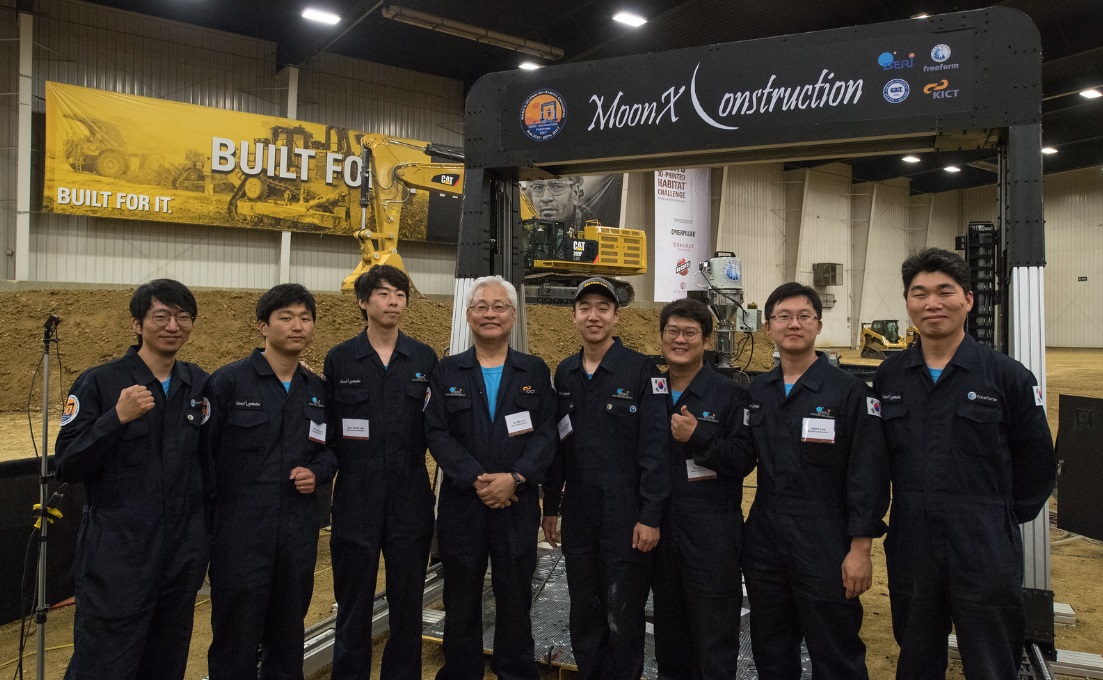Developing the capability for in-situ manufacturing using 3D printing technologies is critical to manufacturing and construction in space, especially if we are to explore or inhabit other space environments, such as Mars, or the Moon. NASA, as part of its Centennial Challenges program, has hosted a 3D Printed Habitat Challenge since 2015 with prize money of over $2.25 million, where the public is encouraged to develop advanced technology solutions to construct sustainable space exploration habitats using 3D printing. The competition was divided into three phases, with Phase 1 focused on Design of the habitat, Phase 2 on development of material technologies and testing of structural members, and the final Phase 3 on the construction and modeling of an on-site habitat.
In a study from Hanyang University, researchers Jin Young Lee, and Tai Sik Lee have developed a three meter diameter by two meter tall structure that meets Phase 3 competition requirements for a one-third scale 3D printed space habitat. Tai Sik Lee, Professor at Hanyang University (Seoul, South Korea) and President of the Korea Institute of Civil Engineering and Building technology, has been doing research into space and extreme construction for more than ten years. He also led the Moon X Construction group, the leading international team in the competition, when they participated and won the Phase 2, Level 2 – Beam Member part of the Structural Member Competition, part of the NASA 3D-Printed Habitat Challenge.
Phase 3 of the challenge was the On-site Habitat competition, for which Hanyang University researchers have published work from their entry in the Journal of the Korean Society of Civil Engineers, in November last year. The NASA 3D-Printed Habitat Challenge is now complete, with winners of the last Phase 3 announced in May 2019. AI Space Factory’s MARSHA structure was announced as the winner of Phase 3 with a striking design made of a combination of a basalt fiber composite and a plant-based bioplastics.
For the Korean researchers, as part of the International Space Exploration Research Institute (ISERI) goal of developing In-situ Resource Utilization (ISRU) construction technologies to enable and contribute to manned exploration of the Moon and Mars, a Korean lunar material simulant was developed, KOHLS-1. This study focuses on identifying an appropriate binding material for KOHLS-1 and building a prototype of the space habitat as required by the competition. The 3D printing material, a combination of lunar simulant KOHLS-1 and polymer-based binders of which a polyethylene glycol combination (PETG) suited best, was manufactured in the form of pellets. This would not only provide an effective method of using lunar or other planetary resources for construction, but can also be used on Earth, for more sustainable, recyclable construction solutions.
In other space manufacturing efforts, the European Space Agency has explored lunar habitat construction that uses sand-like building material and binding salts, and would take just a week to complete one entire building. Made in Space, the company that installed the first 3D printer on the International Space Station (ISS), has also made several advances in 3D printing using polymer and metals in space (and even recycled waste polymer from the ISS), for robotically-built space structures and satellite components, using their Satellite Manufacturing Machine (SMM).
Subscribe to Our Email Newsletter
Stay up-to-date on all the latest news from the 3D printing industry and receive information and offers from third party vendors.
You May Also Like
Precision at the Microscale: UK Researchers Advance Medical Devices with BMF’s 3D Printing Tech
University of Nottingham researchers are using Boston Micro Fabrication‘s (BMF) 3D printing technology to develop medical devices that improve compatibility with human tissue. Funded by a UK grant, this project...
3D Printing Webinar and Event Roundup: April 21, 2024
It’s another busy week of webinars and events, starting with Hannover Messe in Germany and continuing with Metalcasting Congress, Chinaplas, TechBlick’s Innovation Festival, and more. Stratasys continues its advanced training...
3D Printing Webinar and Event Roundup: March 17, 2024
It’s another busy week of webinars and events, including SALMED 2024 and AM Forum in Berlin. Stratasys continues its in-person training and is offering two webinars, ASTM is holding a...
3D Printed Micro Antenna is 15% Smaller and 6X Lighter
Horizon Microtechnologies has achieved success in creating a high-frequency D-Band horn antenna through micro 3D printing. However, this achievement did not rely solely on 3D printing; it involved a combination...

































